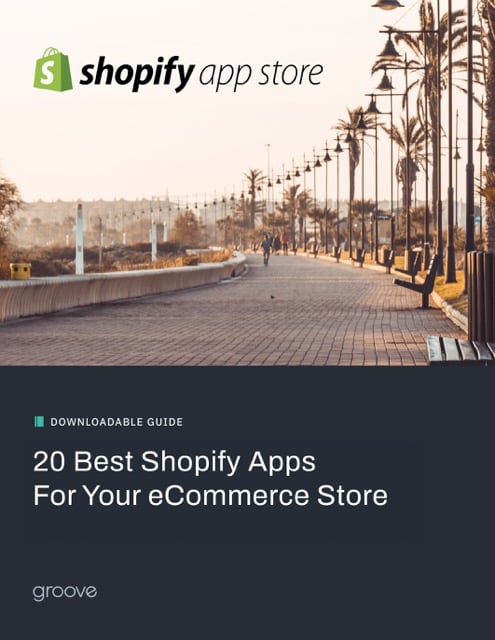We're sorry to break it to you, but there isn't a silver bullet in eCommerce marketing. However, there are some tried and true things to do to get your store moving in the right direction.
When it comes to eCommerce strategy, you have to think about three things – the past, the present and the future.
- What was successful in the past that is still working for you?
- What are you (and your competitors) doing today?
- What is on the horizon that you should be thinking about implementing?
When you answer these questions, you gain a clear understanding of how to move your business forward. Having worked with hundreds of clients, we've boiled our experience of what works (and doesn't) into a few actionable eCommerce hacks to help you grow.
eCommerce Hacks: Our Favorite
- Abandoned Cart Workflows
- Retargeting
- Discounts & Promotions
- Free Shipping & Reliable Fulfillment
- Lead Capture
- Product Page SEO
- Personalized Experiences
- Social Integration
- Mobile Optimization
- On-Site Search
Abandoned Cart Workflows
Although cart abandonment varies by industry, HubSpot reports that an average of 73.9% of carts contain unpurchased items. Whatever the reason, abandoned cart workflows provide the perfect opportunity to recover potential lost sales.
Abandoned cart workflows use automated emails to redirect consumers back to their carts. Typically, we recommend having four-email set up in your workflow.
We specifically outline abandoned cart strategies in a related blog, but in general, we highly recommend this eCommerce hack because it is proven to increase conversion and drive revenue.
If you're a HubSpot user, we encourage your to explore HubShop.ly to easily integrate with your eCommerce platform and power HubSpot abandoned cart workflows.
Retargeting
As omni-channel shopping continues to evolve, more customers follow non-linear purchase paths than ever before. That's why one of the best eCommerce hacks is to nurture your audience as they browse your site, and encourage them to convert.
Retargeting ads allow brands to target users who previously visited a website or are in a contact database (using custom audiences). These advertisements are available on a variety of platforms, including Google Display, Facebook, Instagram and more.
Pixel-based targeting is the most common type of retargeting. This targeting method shows ads to visitors who previously viewed a product or specific website page.
Brands accomplish this by implementing cookies, which notify retargeting platforms to serve specific ads based on website page views or activity. Overall, this method is beneficial because it is timely and effective.
Discounts and Promotions
Online discounts offer numerous benefits that can be incorporated into your eCommerce strategy. However, it’s important to know when to use them.
If your eCommerce store has larger margins, you can use discount offers to increase sales and drive additional revenue. However, if your products have smaller margins, you should avoid heavily relying on discounts because they can eat into your bottom line.
Although discounts and promotions help increase customer acquisition and drive customer loyalty, overusing discounts can reduce profitability. We recommend building custom promotional offers based on your business, customers and goals.
Overall, successfully implementing occasional promotions can encourage customers to convert and revisit your store over time.
Free Shipping and Reliable Fulfillment
Once you've converted a customer, it's time to focus on the in-person experience. Unfortunately, eCommerce shipping can sometimes feel like handing your brand over to a stranger. However, it doesn’t have to be that way.
Shipping is a key part of your business and is the point where consumers finally come into contact with your product. This is why it’s inherently important to map out a successful shipping strategy.
If you haven't considered implementing free shipping, we highly recommend taking the time to evaluate if it's possible for your business. As consumer expectations continue to evolve, free shipping is becoming a requirement for modern eCommerce experiences.
When it comes to fulfillment, businesses should try to automate as much as possible. Tools such as ShipStation also help automate label printing, automatically send order status and tracking info updates to stores and customers.
Lead Capture
Capturing leads is one of the most important eCommerce hacks out there. Grow your email list by implementing a form of lead capture on your website. Keep in mind that this lead capture element is a micro-conversion. In other words, a secondary conversion that isn't a purchase, but on the way there.
Lead capture elements can include:
- Pop-Ups
- Email Subscriptions
- Content Downloads
- Contests and Giveaways
Whatever tactic you choose, including lead capture elements on your online store is proven to increase the number of leads you generate.
Product Page SEO
SEO strategy is one of the best eCommerce hacks when it comes to increasing your online visibility.
Organic search rankings can increase website traffic and organic exposure to help your business drive more sales. Although many brands focus on content development (like blogging) to increase search rankings, we encourage you to also focus on your product pages. This approach will help with your overall eCommerce SEO results.
Remember to optimize your H1s, product descriptions, alt text and other elements to help your products rank for desired keywords. This topic warrants a separate blog in itself, so we recommend exploring our thoughts on eCommerce SEO tools to learn more.
Segmented Personalized Website Experiences
eCommerce websites have the ability to store customer purchase information in a CRM to personalize user experiences. Specifically, brands can adjust customer experiences to show images, products and offers tailored to their specific needs.
Overall, this approach requires thought up front, but can reap significant rewards in the long term. After all, if a customer only purchases women's clothing, showing them a home page experience tailored to those products could drastically increase conversion and time spent on page.
With some technical customization, this level of personalization is available using a CRM like HubSpot with your eCommerce platform. To learn more, we recommend exploring our related blog that outlines HubSpot CRM features and benefits.
Social Integration
Social media is an integral part of today’s culture and buying patters. As a result, eCommerce and social platforms have naturally merged in many ways.
To fully monetize social platforms, brands must integrate their eCommerce platforms to create social shopping experiences.
When properly implemented, these solutions allow brands to share posts on platforms like Instagram with links to products. These solutions reduce browsing friction and help businesses attribute social media efforts with a direct return on investment.
Social integration is natively available with BigCommerce. We recommend exploring this and many other BigCommerce features if you're evaluating SaaS eCommerce platforms.
Mobile Optimization
If your website isn't optimized for mobile, you can't expect mobile conversions.
We recommend building a responsive eCommerce website that incorporates native eCommerce checkouts, connects social marketing and leverages alternative payment methods like Apple Pay and Google Pay.
Although mobile eCommerce trends come and go, it is important to remember that successful website experiences focus on the user first. As a result, brands should choose platforms that focus on mobile ease of use to create a seamless experience regardless of their chosen device.
On-Site Search
Website visitors who use on-site search are three-to-five times more likely to convert than users who don't. Despite this data, many out-of-the-box search experiences are disappointing to say the least.
Consumers taking the time to search what they are looking for from your brand are more invested than any other potential customer on your site. For this reason, brands should focus on site search as a primary conversion tool.
We recommend exploring this eCommerce Site Search Guide to learn more about how to convert high-intent users.
Conclusion
eCommerce success lives and dies with a thoughtful strategy. That said, the above tactics can help any eCommerce business drive growth.
Interested in learning more? Please reach out through the form below, and we'd be happy to chat more about these eCommerce hacks, your business goals and how our team can help you achieve them.

E-BOOK
20 Best Shopify Apps For Your eCommerce Store
Explore tags:
About the author
Subscribe to the Groove Newsletter
Get the latest updates and insights straight to your inbox



